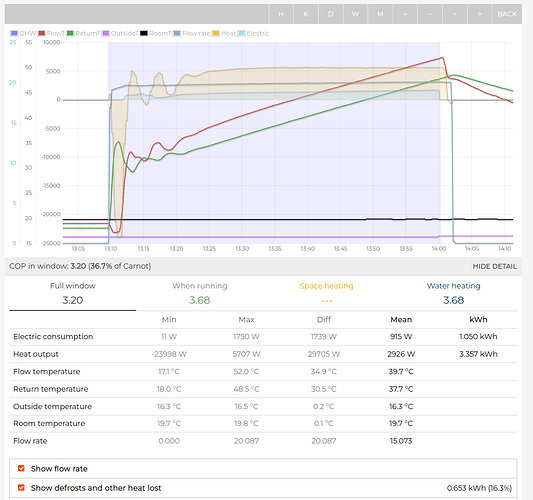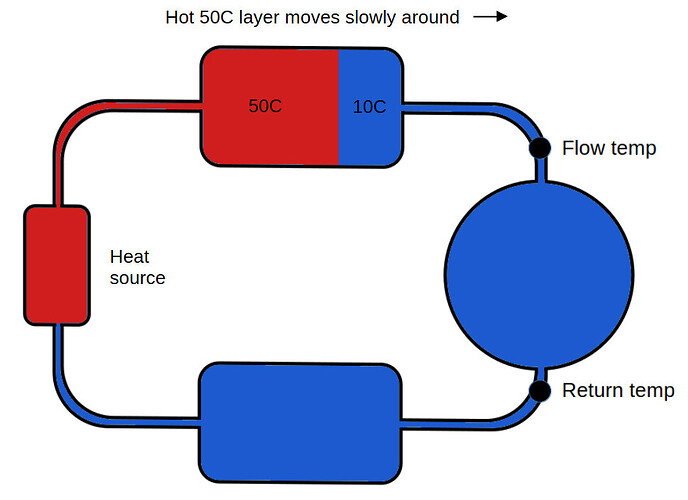I had been scratching my head as to why this Viessmann system https://heatpumpmonitor.org/system/view?id=341 was reporting a lower hot water COP than I would have expected given the outside temperature and flow temperatures being experienced.
This is a 8 kW, Viessmann Vitocal 150A with a HeatGeek cylinder, so all things in place for amazing results.
Here’s an example of the lower than expected performance. COP 3.2, outside temp 16.3C, average flow temp: 39.8C, prc carnot 37%
We can contrast that with one of Damon’s Sheffield vitocal install, COP 5, outside temp 14.4C, average flow temp 40.5C, prc carnot 53%.
In theory at 53% of carnot, system 341 should have got a COP of 4.6 not 3.2 for that hot water run! So why the big difference?
It turns out that system 341 has 30m (60m round trip) of primary pipework out to the heat pump location in the garden. The pipework is 32mm PEX, with an internal diameter of about 26mm, which holds a volume of about 0.53 L/m. 60m is therefore ~ 32L of volume.
In the example above the mean water temperature of the primary circuit rises from 18.5C to ~50C a DT of 31.5K. We can use this to estimate the amount of energy required to heat the primaries up as 4150 J/kg.K x 32L x 31.5K = 1.16 kWh.
The monitor measured 3.357 kWh of heat delivered net using 1.048 kWh of electric. The heat pump actually delivered around ~4.5 kWh (perhaps a bit more if the primary pipework was colder in the outside section). The heat meter is near the indoor unit at the end of 30m run. If the heat meter was outside next to the heat pump it would have registered the heat required to heat the primaries as well, which would have likely resulted in a COP of ~4.3, near enough what we would have expected.
I hadn’t quite appreciated just how much impact long primaries with lots of volume could have - or for that matter the position of the heat meter. There’s obviously often a good reason why a particular install might need longer than usual primaries, the energy lost in the primaries is just one factor that needs to be weighed up against others.
The impact on COP is also much less during the heating season, especially when the heat pump is running continuously. The primary pipework will already be pre heated from space heating and after the hot water cycle finishes, the hotter primaries go straight back to work moving heat for space heating.
System 341 does one hot water heat up per day, if it did multiple shorter top up’s the impact could be even greater, or alternatively the impact could be less if the hot water tank is left for a bit longer. E.g if your loosing 1 kWh every time (depending on cool down period of course) and you transfer 3 kWh to the cylinder that’s a greater COP impact than if you transfer 6 or 9 kWh to the cylinder.
If you turn on ‘show defrost and heat lost’ in the detail section of the power view, there’s something interesting at the start of the cycle.
Dashboard link: Emoncms - app view
-
A slug of relatively warm water is moved from cylinder hot water coil around the primaries. 0.653 kWh is initially lost, some of that probably comes back as you can see the heat wobble around for a bit. The system has effectively taken a little heat out of the cylinder and that has preheated the primary pipework a bit, the mean water temperature rises from 18.5 to ~34C in that time.
-
At the end of the cycle the central heating pump promptly stops before the diverter valve switches back to space heating, there is no large spike of heat output that corresponds to a slug of hot water from the primaries being diverted around the central heating system. We do see this when the system switches to space heating when it gets colder but not here during warmer temperatures.
-
We actually measured 4.01 kWh of heat delivered gross (3.357+0.653), but did not measure the remaining 0.5 kWh or so given the position of the heat meter in the system.
Conclusions:
-
Primary volume before the heat meter could be another important factor that explains apparent differences in the % carnot figure when comparing systems on HeatpumpMonitor.org.
-
The position of the heat meter makes a difference, closer to the heat pump will give higher COP’s as you capture more of the heat. That said if your actually interested in the effective heat transfered to the hot water cylinder you would want to be near the cylinder. This matters less on systems with short primary pipework runs of course.
-
If you can avoid long primary pipe runs it may be worthwhile, though as ever this needs to be weighed up against other factors.
-
Further work is needed to assess annual impact on SPF.






